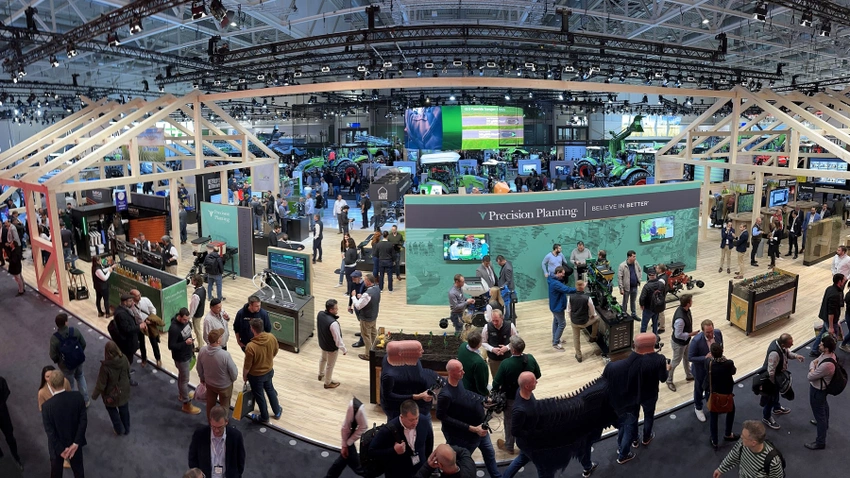The Food and Drug Administration said recently that the U.S. food supply is still "one of the...
Five Takeaways from Agritechnica 2023

After a four-year break, the crowds returned in force to one of the world’s largest farm shows, and there was plenty to see. The show, which normally runs every other year, was last at work in 2019. Plenty has changed in that time, and that was evident on a walk through the show floor.
For years, Agritechnica in Hanover, Germany, has been a place where companies show off innovative tools and prototypes. While the 2023 event was the first time many saw the new machines, one European journalist said a lot of the tools had been shared ahead of the show. That’s likely one of the bigger changes since 2019: YouTube has become the venue for many manufacturers to reveal their new equipment. Still, there were first-ever unveilings of machines such as the Massey Ferguson 9S tractor line and the New Holland CR11 combine.
Looking through notes and photos from the show, one journalist reported a few takeaways from this year’s event:
- Autonomy grows.The range of autonomous vehicles on display has expanded tremendously — from machines already commercialized in specialty markets to massive prototypes that will come in a few years. In the United States, farmers are concerned about labor shortages on the farm. Turns out, it’s a big deal in Europe, too.
One exhibitor told me he didn’t think they could get someone from town to work on a farm even for 50 euros an hour (about $53). As a result, the labor shortage is driving the rise of the farm robot, although regulatory hurdles regarding safety still must be cleared.
Soil health is a growing consideration for autonomy. Farm robots can be smaller, making a lighter touch on farmland. It’s not the chief driver, but it came up in several discussions with exhibitors.
- Regulations drive innovation.While glyphosate did get cleared for use in the region for another decade, the push to reduce the use of crop protection products is growing. In specialty markets, this is leading to the development of precision tillage tools that can cut between plants as well as move through the row.
You’ll hear farmers and industry folks discuss the rules being made in places like Berlin and Antwerp as being “out of touch” with what agriculture needs. Europe still bans planting of biotech crops, though imports of soybeans and corn with the technology are allowed. Gene editing is still on the bubble, but the European Commission sees its potential for a sustainable and resilient food system.
For crop protection companies, the focus is more precision spraying, which means targeting just the weed, not the crop. And precision spraying was a focus for many exhibitors including imagery firms, software makers and equipment manufacturers.
- Sense-and-act gains traction.This is related to the second point. Regulators want the use of crop protection products reduced, which means turning every sprayer into a “weed only” sprayer. That’s the most visible use of sense-and-act technology, but the rising use of sensors for managing equipment in new ways will likely boost efficiency.
One manufacturer showed off a vision-based system that tracks a tillage tool as it moves through the field. If a wing on a shank breaks, the system will know and can alert the farmer long before it would normally be discovered.
Deploying sensors, imaging and other tools to manage equipment was on display throughout the show.
- Precision Ag’s role grows.Social media carried some interesting chatter about carbon. While carbon sequestration is still part of the conversation, the discussion has become broader. The use of precision-ag tools to better manage inputs has expanded to become the backbone of a sustainability effort.
That changes the conversation for farmers who may be able to better deploy data to manage more than carbon on the farm, benefiting both the environment and perhaps the bank account. However, one farm equipment company executive noted that farmers are still not using all the precision information they’re collecting on their farms today.
- Innovation comes in many forms.Strolling through the many buildings at Agritechnica reveals that technology is being deployed in a variety of new ways. Electric tractors gained some attention, though current battery and horsepower limits keep those tractors confined to smaller farms for now.
Interest is found in alternative fuel sources such as methane and HVO. HVO stands for hydrotreated vegetable oil, which in the U.S. is more commonly known as renewable diesel. It’s the drop-in replacement for fossil-fuel-based diesel, instead of biodiesel. Most manufacturers discussed their engines’ capabilities to use HVO.
Farm shows gather innovation in one place to allow farmers to kick the tires, see tools and talk to experts. The large crowds at Agritechnica 2023 proved that farmers were just waiting for a chance to get back to Hanover, Germany, to check out what’s new.
EDITOR’S TAKE:
Agritechnica is known to most farmers/ranchers/equipment OEM’s as one of the premier events to showcase ag equipment and innovation. COVID put the show on hold for a few years, but it is now back on cycle. The observations emanating from the show simply underscore the advancements in technology being introduced to farmers/ranchers worldwide. Fortunately, U.S. farmers lead the way when it comes to adopting and improving new innovations. They are constantly seeking new ways to become more efficient, productive and profitable. You can rest assured that the innovations from this year’s event will be showing up on a farm or ranch in your area in the near future.








